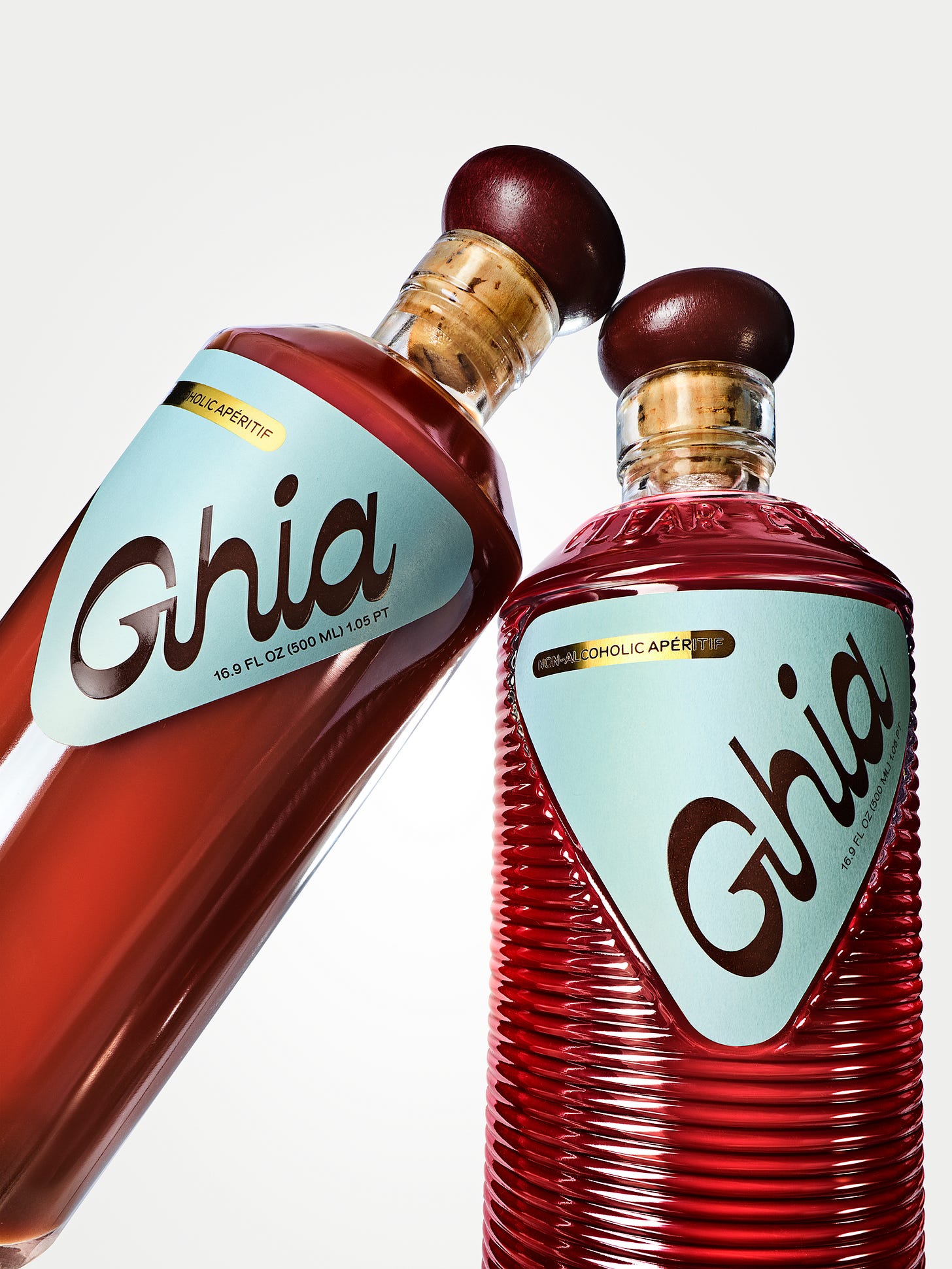As I wind down this newsletter, I realize that Mélanie Masarin, the founder of nonalcoholic apéritif brand Ghia, has not yet made an appearance on Good Drinks. I could think of no better person, then, to interview in my penultimate entry, not only because my fridge is never not stocked with Ghia's Le Spritz (both the OG and ginger flavors) but also because Masarin released a 2.0 version of the hero product today. Please find an edited and condensed version of a conversation Masarin and I had this past Saturday—yes, we both work too much—below.
You’re changing things up at a time when I sense that you’re emerging as a category leader, and your press release says the brand has grown by 77% over the past year. What’s the thinking behind tweaking the recipe and why now?
Now that people think of this category and think of Ghia, I feel a greater responsibility to make it more approachable. Ghia was centered around inclusivity on so many different levels: We wanted the drink to be able to be consumed by pregnant women, we wanted the drink to be non-triggering to people who were in recovery, we wanted to make sure the drink would be safe and wouldn’t buzz you in any way. And when we think of inclusivity, obviously price comes into play. We really wanted to lower the price, but we didn’t want to lose on the quality, so we decided to concentrate it more. We now have 17 servings per bottle instead of 10.
There’s often a lack of transparency in the beverage industry as a whole: What does it cost to make things? There’s the idea that alcohol is expensive because it’s taxed. Yes, but [many alcohol brands’] ingredient costs are low, and a lot of [perceived value] is also big marketing campaigns making us feel that we need alcohol to be the life of the party.
For us, ingredient costs were probably six or seven times higher than any alcoholic or even a lot of nonalcoholic drinks because we don’t use artificial flavors. We only use natural extracts and juices. The companies that we look up to, they’re not other nonalcoholic companies; they’re flavor companies like Empirical Spirits. We really wanted to be known for the taste of the product, and it’s expensive to make products in small batches in a very ingredient-forward way.
And production is really expensive. Cans and bottles, when they come in, they sell first to Pepsi and Coca-Cola, and then we get them on the secondary market. So, they pay half basically most of the time. And that’s just the way it is.
Speaking of ingredients, you swapped out fig for a combination of date, plum, and rhubarb root. Is that correct?
Yes. When you have real extracts, they can interact with each other and the stability of the formula is obviously very hard to preserve because you don’t have alcohol inside. Fig was our most complicated ingredient, because it’s very alive. We’d been trying to figure out how to replace that sweetness without just adding added sugar, and we ended up using a tiny bit of date and then some plum to keep the roundness. We also swapped our grape. We were really fighting to find Riesling that was made for the juice industry. Most Riesling is made for the wine industry and we were buying Riesling from any small farm that we could in order to have it juiced. It was prohibitively expensive and every batch of Ghia tasted crazy different. We knew we wanted a grape that was from one place that would have the supply but that was very high-quality and wasn’t too sweet, and we eventually found an Argentinian grape that we really loved. But with each change, the entire balance of the drink changes, so you have to reformulate all over again.
Sorry, I’m blabbing, but another thing about the reformulation: I was always a little bit dissatisfied with the separation that came with Ghia. Customers were getting more educated about how sedimentation is natural—the natural wine industry did that work for us—but the reality is, it’s also sometimes a sign that things are not emulsifying properly. Ghia was never going to look like Aperol, but there were steps that we could take to [improve the clarity]. But that ring of ginger at the top of the bottle, I just couldn’t believe that we couldn’t get rid of it! I think we tested 20 different gingers, and then one day it became really clear: We just had to make our own. So, we now make it in-house using a proprietary extraction process that is very gentle on the flavor compounds and makes a ginger that naturally emulsifies better within the bottle. [The orange and rosemary extracts are made in-house now, too.]
So, there was concentration and reformulation of the liquid. What about the change to the bottle?
We’ve been sitting on this design forever; it was always on the vision board. Adding the rib creates a sensory dimension to our bottle and it personally makes me want to gravitate towards it more, to grab it. It’s hard to explain, but we want it to make people feel as drawn to it as a gorgeous liquor bottle—and it really “feels like Ghia.”
I’m curious about something you said earlier, that you wanted to make something that wouldn’t be triggering to those who are in recovery. How do you test that?
It’s obviously very personal. For certain people, just the thought of just making a cocktail would be triggering to them, so we wouldn’t say definitively that Ghia is not. But I think we’re mindful about not creating a drink that mimicked an alcohol flavor. I was able to ask some people in my family who are going through the [recovery] process and some friends as well. Some of them wouldn’t go near Ghia, but some of them really enjoy it.
From what I understand, the vast majority of people who are purchasing alcohol replacements such as Lyre’s products are people who also drink.
I don’t have a hard number, but we estimate that about 85% of our customers identify as drinkers and are seeking moderation. I think that that’s the most interesting and surprising thing about the category because when I created this product, I was not drinking at all. I’m still not.
I see. So, the numbers I’ve seen track with Ghia’s data.
When we raised our first round of funding, the premise was, “There’s X number of people in the U.S. who don't drink,” right? It was either their age, they’re sober, or they don’t drink for religious reasons or whatnot. Then “sober curious” came to be, and some people initially felt a certain way about the term, but now it’s more commonly accepted to just not be drinking for whatever reason. So, that boundary has diminished tremendously.
How do you account for Ghia’s growth? I’m no businessperson, but 77% seems like a big jump in a one-year space of time.
For sure, and especially in this year when things are just not as frothy as they used to be. I think the biggest driver of growth for us is that finally, small chains are making room for the category on shelves. You saw me build the business: I would send Instagram DMs to all the independent accounts that were doing manual buying because I thought maybe they would take a chance on us. Now [we’re sold at] Bristol Farms and Lazy Acres. Also, Amazon is doing very well and I think it’s coming from every state in the country, which is so exciting to me.
Is there anything more to say about the regional variations in business?
It seems to be that Ghia does really well in cities that booze a lot, which is not that surprising. And California is bigger than New York for us.
How else do you assess how the landscape has changed in these past few years?
We’re not there yet, but there are 250 CVS locations that are not in coastal cities or New York or L.A. or even Texas that have full nonalcoholic aisles that are doing so well and they’re taking on 10 more brands by the end of the year.
Wow.
Yes, right? And that’s happening before Whole Foods.
Wow!
That’s not because of me, that’s not because of my Instagram followers, and it’s not because of Ghia. I think it’s because people know that they feel better without booze. So naturally, I think there’s more stickiness to this category than people expected. Personally, I’m not shocked by it but I’m delightfully surprised to see how many more restaurants have Ghia on the menu or have nonalcoholic menus. You can go to the Carlyle and there are four nonalcoholic alcoholic drinks on the menu that are very high-quality and taste absolutely delicious. That’s something that we couldn’t have hoped for five years ago.
Any other surprises in the years since launch in 2020?
We definitely went through some hurdles. It was COVID, then it was the supply chain, and now we could really think about this reformulation. Our packaging is also all moving: There’s no more color on the box, everything’s biodegradable, the box is recycled and recyclable. We just feel more responsibility to lead the way, which is an honor but also quite scary. I have never been more nervous for launch because it’s also like, “What if people don't like it?” Because there were so many changes that were so gradual, it’s the first time we couldn’t co-create this product with our community, which we’ve never done before. And so, I’ve never been more nervous.
What about the future of Ghia, after this relaunch?
We work on so many new flavors, but I want to be very intentional about how we launch them. And do we go into a new category of beverages or not? This is a big question for us because I love the world of apéritifs, but the American palate doesn’t necessarily love dry drinks or bitter drinks. We estimate only about 25% of the American population likes bitter, which is so much less than, say, in Europe for instance.
Which would be what? Just to have a sense of how to compare.
Apéritif culture is just so ingrained in everybody’s life there. I don’t have a number, but I estimate more than double that, right? But I don’t want to make a drink that’s full of sugar. Also, the more Alpine flavors or other Mediterranean flavors that I love which are often very licorice-based, they definitely don’t work here. But we’re working on different things and figuring out where they fit.
The next newsletter entry will be my last. I’m thinking about what to say, because you deserve a proper goodbye; it will arrive when I arrive at the right words, some time in the next week or so. Until then, drink up!








Awww this was one of my favorite issues. Really great interview and learned lot about where the costs come from. You'll be missed Julia!
Just when I thought I couldn't love Ghia more <3